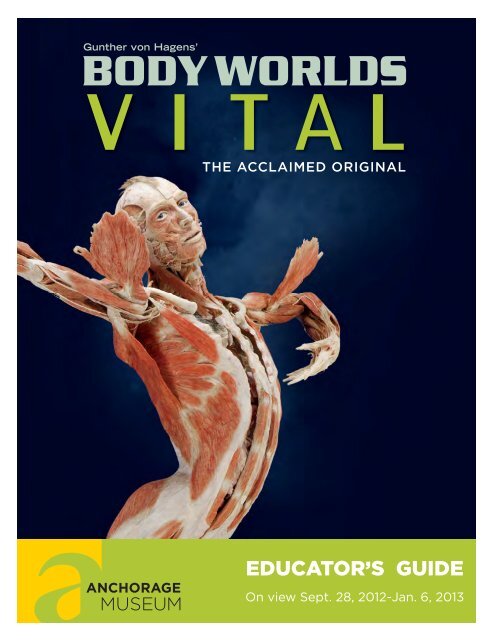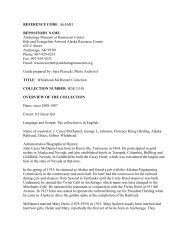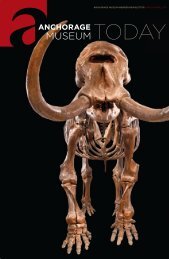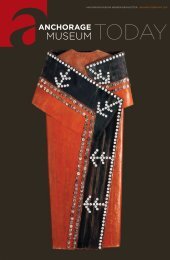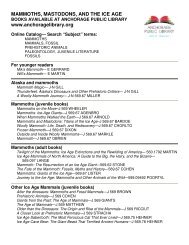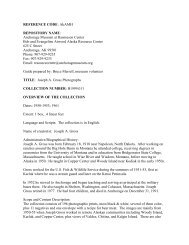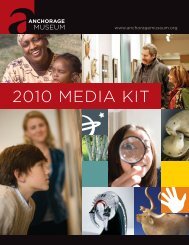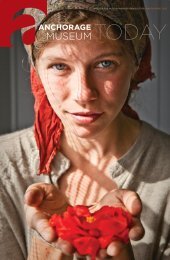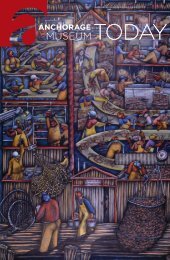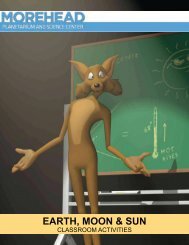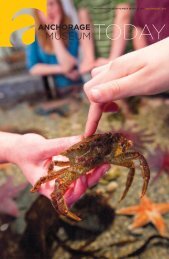Body Worlds Vital Educator Guide - Anchorage Museum
Body Worlds Vital Educator Guide - Anchorage Museum
Body Worlds Vital Educator Guide - Anchorage Museum
- No tags were found...
You also want an ePaper? Increase the reach of your titles
YUMPU automatically turns print PDFs into web optimized ePapers that Google loves.
A Message from Our SponsorWelcome educators,We all know that maintaining a healthy lifestyle is important forour mental, spiritual, and physical well-being. Exercising regularly andchoosing nutritious foods can lead to fewer chronic diseases and alonger life. Still, Alaska’s high rate of obesity shows us that makinghealthy choices can be a challenge in our increasingly busy lives.<strong>Body</strong> <strong>Worlds</strong> <strong>Vital</strong> is designed to illustrate the essentialcomponents of human health and wellness. The exhibition gives acomplete picture of how the human body functions while retainingthe dignity of those who donated their bodies to this effort. <strong>Body</strong>World <strong>Vital</strong> tells a story of how to prevent life-threatening diseasessuch as cancer, diabetes, and heart disease through informed lifestylechoices. By managing our own health, we can help avoid these costlyand painful chronic diseases.As educators, you know firsthand that children who suffer fromchronic health conditions may be disadvantaged in learning, a crucialelement of a successful life. As the state’s largest health care providerand private employer, we also have a deep understanding of theimpacts of an unhealthy lifestyle.Providence aims not just to be a leader in health care but a leaderin health by encouraging both our employees and our communitiesto follow the path to a healthy lifestyle. To this end, Providencesupports childhood wellness through Healthy Futures, <strong>Anchorage</strong>Running Club, March of Dimes and Boys and Girls Club. Collaborativeprevention efforts such as these address diseases in young Alaskansto ensure a healthy future.Even the smallest changes can lead to significant improvementsin our overall health. We hope the <strong>Body</strong> <strong>Worlds</strong> <strong>Vital</strong> exhibit inspiresyou and your students to make intentional changes that lead to ahealthier and more joyful life.Bruce Lamoureux, chief executiveProvidence Health & Services AlaskaA MESSAGE FROM OUR SPONSOR 5
Student ProgramsGUIDED INVESTIGATIONSEnhance your students’ <strong>Body</strong> <strong>Worlds</strong>experience with a <strong>Guide</strong>d Investigation andSelf-Explore package. Premium admissionfees apply to <strong>Body</strong> <strong>Worlds</strong> Self-Explore.Available Fall (Sept. 11-Dec. 14) Tuesdays,Wednesdays, and Thursdays at 10:30 a.m.or noon. 45 minutes.Art and the <strong>Body</strong> (5–12)One of the greatest inspirations for anartist is the human body. Students learntechniques for representing and celebratingthe human form through hands-on paperactivities and drawing exercises. SouthClassroom. Arts Standards: A, B, D. ScienceStandards: A, E, G, F.Eye To Eye (6–12)Students explore the complex functions ofthe eye while observing the similarities anddifferences between cow and human eyes.Students also work through the scientificprocesses of observation and dissection.North Classroom. Science Standards: A, C.Thomas PlanetariumMicrocosm: The Adventure WithinAt the center of nano medicine in the year2053, viewers shrink down to the size of amicrobe and get injected into a patient whois suffering from a mysterious virus. Alsoavailable in Spanish by request. 16 minutes.Science Standards: C.Field Trip RegistrationFor more information onregistering your school groupvisit anchoragemuseum.org/learnor call (907) 929-9280.CORRELATION TO STANDARDSThe <strong>Body</strong> <strong>Worlds</strong> <strong>Vital</strong> exhibition maybe used to meet a broad range ofAlaska Standards, including Content andPerformance Standards in Reading, Math,Science, Social Studies, and Fine Arts, aswell as the Alaska Standards for CulturallyResponsive Schools. However, the exhibitionmost closely aligns with the followingAlaska Content and Performance Standards:Skills for a Healthy Life: A-DArt: DCultural: A-EScience as Inquiry and Process: AScience and Technology: EHistory and Nature of Science: GCultural, Social, Personal Perspectives,and Science: FSchool groups pay a fee per program inaddition to individual student admission.Admission rate is $8 per student for entranceinto <strong>Body</strong> <strong>Worlds</strong> <strong>Vital</strong>. Additional fees applyfor docent tours, guided investigations, andplanetarium shows. Admission is free forchaperones within the allotted ratio of oneadult per five students. Adults beyond thisratio must pay $8, which includes generaladmission and premium exhibition fees.When registering for field trips, pleaseremember the museum is closed onMondays from Oct. 1 through April 30.Student programs are available Tuesdays,Wednesdays, and Thursdays. Docent-ledtours, self-guided free exploration, andplanetarium shows are available Tuesdays,Wednesdays, Thursdays, and Fridays. Whenconducting field trip activities, please beconscious of traffic flow and allow ampletime for self-guided exploration in otherareas of the museum.STUDENT PROGRAMS 6
Letter to StudentsDear student,Have you ever watched a professional basketballplayer seem to float in air as he or she leaps up todunk the ball in the basket? Or maybe you watchedskiers and skaters competing at the Olympics andwondered “How did they do that?” Well, our bodiesare pretty amazing. And the more we learn aboutourselves and how our bodies work, the better we cantake care of ourselves and others and the healthier wewill be — making us better on the ice rink, basketballor tennis court, jumping hurdles, or just walking downthe street.<strong>Body</strong> <strong>Worlds</strong> was developed by German doctorand anatomist Gunther von Hagens to help peopleunderstand how their bodies work by offering a lookinside real human bodies. When you visit with yourschool or family, you will see exactly how your brainand your heart look and what happens to them whencertain diseases take over. You will see how smokingdestroys your lungs and how your bones, muscles, andligaments all work together so you can dance or run.The activities inside this guide will help you learn moreabout the human body. Then come see <strong>Body</strong> <strong>Worlds</strong>.You’ll really get to know yourself!Dr. Angelina WhalleyConceptual Designer for <strong>Body</strong> <strong>Worlds</strong>and Managing Director of the Institute for PlastinationLETTER TO STUDENTS 8
Exhibition Themes<strong>Body</strong> <strong>Worlds</strong> <strong>Vital</strong> encourages students to explore how different anatomical systems work in thehuman body. The following themes featured in the exhibition may be useful in framing how thecontent connects with your curriculum:Art in Science: The beauty of the bodyStudies of anatomy have always been a key part of art education. Artists who know how thehuman body is put together and how its muscles work are better able to portray people inpainting, sculpture, and other art forms.The Locomotive System: Makes motion happenThe locomotive system is the system in the body that makes movement possible.The Nervous System: The messenger and the bossThe nervous system is the system of the body that controls movements, thoughts, and emotionsthroughout the body.The Respiratory System: Oxygen in, carbon dioxide outThe organs of the respiratory system work together, along with other body systems, to ensure thebody’s cells receive the oxygen they need to live.The Cardiovascular System: The body’s great pumpCardio means heart, and the cardiovascular system is essential to our survival. The cardiovascularsystem is sometimes referred to as the circulatory system because it’s responsible for thecirculation of blood through the body.The Digestive System: Converting food into energyThe body’s digestive system converts the food you eat into the energy you need to live.EXHIBITION THEMES 9
Art in Science:The beauty of the bodyBODY WORLDS VITAL teaches a greatdeal about the science and anatomy ofthe human body. It also teaches about theform and art of the human body. Studies ofanatomy have always been a key part of arteducation. Artists who know how the humanbody is put together and how its muscleswork are better able to portray people inpainting, sculpture, and other art forms.This knowledge is important, even ifartists choose to represent the humanform in abstract ways rather than realisticrepresentation. In the <strong>Body</strong> <strong>Worlds</strong>exhibitions, Dr. Gunther von Hagens haspositioned human figures to reveal how thebody is put together and how it performsdifferent tasks.He also presents human figures in waysthat highlight different body systems. Forexample, a group display called “The BloodVessel Family” reveals the human formthrough its network of blood vessels.The scientific choices he has made givevisitors a new way to understand how humanbodies work. At the same time, he hasrevealed how beautiful the form and systemsof the human body are.As visitors go through the exhibition,they learn the science of anatomy. They alsoget to experience the artistic qualities ofanatomy. This helps the exhibition appeal toall students, not just those in science classes.THINK LIKE AN ARTISTLike Dr. Gunther von Hagens, artistssometimes focus on one aspect of a figure.In art, this can be achieved by emphasizingone feature of a person, or showing thesubject from an unusual angle or perspective.Explore this idea by thinking about someonein your family. Reflect on what this personis like, or what you admire about him or her.Then think about what you would focus onif you were to portray this person artistically.Sketch your artwork concept and explainyour ideas to the class.PHOTOS AS ARTNewspaper photographers often are askedto take portraits of people for the news.These portraits often could be consideredphotographic artworks. Look through thenews and features sections of the newspaperfor several days and clip photos portrayingpeople. Pick the one you like the most andexplain to the class what makes the portrayaleffective or artistic in your eyes. Finish bygiving the photo a title, and explain itto classmates.SPORTS ANATOMYCoaches need to know how to evaluate thephysical skills and talents of players. Thesetalents often are based on anatomy. Pickan athlete you admire. Then think aboutthe different body systems explored in thisguide. Write out which systems contributemost to the success of this athlete.ART IN SCIENCE 10
The Locomotive System:Makes motion happenTHE LOCOMOTIVE SYSTEM is the systemin the body that makes movement possible.It consists of the bones that make up theskeleton, the joints that hold the bonestogether, and the muscles that contract andrelax to actually make you move.The skeleton is the framework of thebody, and it is made up of bones andcartilage. Bone is made mostly of calcium,which is why it is important to drink milk tokeep your bones strong. Milk is a food that isrich in calcium.Inside the bone is sponge-like mattercalled bone marrow. This makes boneslight so people can move easily, but strongenough to support body weight. Bonemarrow also produces red and white bloodcells. Red blood cells have hemoglobin andcarry oxygen. White blood cells produceantibodies to attack bacteria, infections,and diseases.The skeleton has many jobs. It providesprotection to internal organs, it supports thebody and gives it shape, and it provides aplace for muscles to attach.Bones are important to almost everymovement we make. Bones couldn’t move apencil, though, without help from muscles.Muscles consist of cells that contract.Muscles and bones are connected bytendons, which are something like ropes.When a muscle contracts, it pulls the tendon,which then tugs on the bone, and everythingmoves. Although it may seem easy to dosomething like throw a ball, it’s actuallycomplicated when looked at inside the body.To make the motion of throwing, manymuscle groups in the shoulders, arms, chest,abdomen, and even legs must be used. Eachof these groups must work together withnerves in order for motion to occur. And allthis happens in a fraction of a second!Voluntary muscles are used when youthrow a ball. These are the muscles wecan control. People also have involuntarymuscles, which we cannot control, such asthe heart and the stomach.The joints are another important part ofthe locomotive system. Joints are positionedbetween major bones that come togetherand help you to move and bend.There are different kinds of joints,including ball and socket joints in the hipsand hinge joints at the knees and elbows.Joints are surrounded by capsules containingfluid that help the bones move smoothly.Learn with BODY WORLDSThe bones of the human skeleton givethe body both strength and structure.A strong and healthy skeleton isimportant for every person for bothwork and recreation. Think of threethings that you do every day thatinvolve the use of certain bones.THE LOCOMOTIVE SYSTEM 11
The Nervous System:The messenger and the bossTHE NERVOUS SYSTEM is the system ofthe body that controls your movements,thoughts, and emotions.There are two parts to the nervous system:the central nervous system and theperipheral nervous system. The centralnervous system includes the brain and thespinal cord. They work together with nervesto send messages back and forth betweenthe brain and the rest of the body.COOL FACTThe nervous systemcarries messages fromthe brain to other partsof the body at more than100 miles per hour.The brain is the boss. It has five parts:The cerebrum, the cerebellum, thebrain stem, the pituitary gland, and thehypothalamus. The cerebrum is the biggestpart of the brain and controls thoughts,language, and voluntary muscles, which arethe muscles you can control. You also usethe cerebrum when you think hard in schooland when you need to remember things.The cerebellum is a lot smaller than thecerebrum, but still very important. It controlsbalance, movement, and coordination. If itweren’t for the cerebellum, you wouldn’t beable to stand without falling!The brain stem connects the rest of the brainto the spinal cord. It’s the part in chargeof major things that keep you alive likebreathing, blood pressure, and digestingTHE NERVOUS SYSTEM 12
Finally, the hypothalamus regulates yourbody temperature, your emotions, andhunger and thirst.The brain has many jobs, but it needs helpfrom nerves and the spinal cord, too. Everyaction you do happens because your brain,nerves, and spinal cord work together.food. Unlike the cerebrum, the brain stemcontrols the involuntary muscles — the onesthat work without you thinking about it, suchas the heart and stomach.The tiny pituitary gland produces andreleases hormones into the body —hormones like those that help you growand change.The nervous system includes millions andmillions of neurons, which are microscopiccells. When you do something, messagestravel from the neurons to your brain.The peripheral nervous system is composedof the nerves and neurons that go outsidethe central nervous system to operate thebody’s limbs and organs. It is here thateverything gets connected.Next time you take a test, drink a glass ofwater, laugh or do anything at all, thank yournervous system. Actually, you can thank itright now since it just helped you read this!Learn with BODY WORLDSThe nervous system carriesmessages to the brain that make itpossible for the body’s five sensesto work. The five senses are touch,taste, hearing, sight, and smell.Explore the five senses by writingabout one of your favorite thingsfor each sense. For example, youmay say that you enjoy listening toclassical music, because it helps youconcentrate. This relates to yoursense of hearing.THE NERVOUS SYSTEM 13
The Respiratory System:Oxygen in, carbon dioxide outTHE ORGANS OF THE RESPIRATORYsystem work together, along with other bodysystems, to ensure that the cells of the bodyreceive the oxygen they need to live.When you breathe in, the muscles of yourchest expand. Your diaphragm lowers andcreates lower air pressure in your lungs thanin the world outside. This causes air to enterthrough the nose or mouth.Once air enters, it travels past youresophagus, sometimes called the “foodpipe,”and is moistened as it goes down thetrachea, or “windpipe,” into the lungs. As airenters the lungs, the lungs expand outward.Once inside the lungs, the air travels throughtubes called bronchi, into smaller tubescalled bronchioles, which get smaller andsmaller until they reach alveoli, which aresacs about the size of a grain of sand.COOL FACTYour left lung is a bitsmaller than the right, toleave room for your heart.The air you breathe enters the body’s bloodthrough the walls of the alveoli. The bloodreceives the oxygen, and in return passescarbon dioxide into the alveoli. The cells ofyour body need oxygen to live, and carbondioxide is the waste cells leave behind.Your red blood cells are little workers thatcarry the oxygen to the cells, and take thecarbon dioxide away. Smoking, as we allknow, makes the lungs less healthy and canlead to death.One of the reasons for this is that smokingmakes little structures called cilia stopworking. Cilia move within the lungs to helpclear things out. Smoking disables or evenkills them. Then harmful particles stay inthe lungs.THE RESPIRATORY SYSTEM 14
Plants take the carbon dioxide that werelease and use it to create oxygen, which weneed. We in turn take oxygen and turn it intocarbon dioxide, which plants need. This iswhat is called a symbiotic relationship — onethat is good for both organisms. Try to thinkof other ways in which humans interact withnature in symbiotic relationships.Another bad effect of smoking is thatchemicals build up in the lungs, and thedelicate alveoli can become thickened,swollen, and unable to exchange oxygen andcarbon dioxide with the blood in a healthyway. This condition leads to emphysema, along-term, progressive disease of the lungsthat primarily causes shortness of breath.Learn with BODY WORLDSA healthy respiratory system makesit possible for people to live activelives. Smoking causes problems for therespiratory system. Make a list of fivereasons why you shouldn’t smoke.THE RESPIRATORY SYSTEM 15
The Cardiovascular System:The body’s great pumpIMAGES OF HEARTS ARE often used tosymbolize romance or love. But moreimportantly, the heart is the central organ ofthe cardiovascular system.Cardio means heart. The cardiovascularsystem is sometimes referred to as thecirculatory system because it’s responsiblefor the circulation of blood through the body.COOL FACTAt every stage of life,your heart is aboutthe size of the fist youmake when you closeyour hand.This system consists of the heart, which isa muscular pumping device, and a closedsystem of vessels called arteries, veins, andcapillaries. The cardiovascular system’s vitalrole is to provide a continuous and controlledmovement of blood through the thousandsof miles of microscopic capillaries that reachevery tissue and cell in the body.Human survival depends on the circulationof blood to the organs, tissues, and cells ofyour body. Arteries carry blood enrichedwith oxygen away from the heart, and veinscarry blood that has used up its oxygen backto the heart. Through the heart and lungs,the blood gets a fresh supply of oxygen anddelivers it to the rest of the body.THE CARDIOVASCULAR SYSTEM 16
Twenty major arteries make a path throughthe tissues of the body. Then they branch outinto smaller vessels called arterioles. Thesebranch further into the capillaries, most ofwhich are thinner than a hair — some so tiny,in fact, that only one blood cell can movethrough at a time.Once the blood in capillaries delivers oxygenand nutrients, it picks up carbon dioxide andother waste. Then blood moves back throughwider vessels, called venules. These eventuallyjoin to form veins, which deliver the bloodback to your heart to pick up oxygen.If all the vessels of this network were laidend to end, they would extend about60,000 miles, far enough to circle Earthmore than twice!Because all the tissues in the body rely onit, the cardiovascular system appears earlyin developing embryos — in the fourth weekafter fertilization — and reaches a functioningstate long before any other majororgan system.Learn with BODY WORLDSThe cardiovascular system is a delicate system and can be affectedby many things. Fats and cholesterol, for example, can slow or evenblock the flow of blood in the body. Fats and cholesterol enter thebody through foods people eat, and that is one reason people areencouraged to limit the amount of fatty or oily foods they eat. Think of10 fatty foods and 10 healthier options. For example, you may think ofa doughnut as a fatty food and toast as a healthy alternative.THE CARDIOVASCULAR SYSTEM 17
The Digestive System:Converting food into energyTHE BODY’S DIGESTIVE SYSTEM convertsthe food you eat into the energy you needto live.The journey through your digestive systemis a long one for food. It starts in the mouth,where teeth grind and tear the food into smallpieces. Saliva then wets and softens the food,and begins to dissolve carbohydrates. Oncethe food is properly mashed and wet, it ispushed by muscle action into the pharynx, orthroat, and down the esophagus, which leadsto the stomach.When food reaches the stomach it is mixedand broken down further by acids thestomach produces. The stomach protectsitself from these acids by secreting a layer ofmucus that lines the inside of the stomach.COOL FACTYour mouth makes abouthalf a quart of saliva eachday, and you produce a totalof about seven quarts ofdigestive juices.Some things, such as water and sugars, canbe absorbed right out of the stomach andinto the bloodstream. The things that needmore digestion have further steps ahead ofthem. When the stomach has made the fooda liquid, the food passes through a valve intothe small intestine.The small intestine has a large surface areabecause it contains villi. Villi are tiny littlestructures like very short hairs that stick outinto the small intestine. Through the wallsof the villi nutrients from food pass into thebloodstream. The bloodstream carries thenutrients to your cells so they can live.THE DIGESTIVE SYSTEM 18
Once all the useful nutrients have been takenfrom food in the small intestine, the unusableparts pass into the large intestine, or colon.In the large intestine, water is extracted fromthe waste and the material hardens into feces.The feces is passed out of the body when yougo to the bathroom.DIGESTIVE HELPERSThe pancreas, liver, and gallbladder areall organs that do things important to thedigestive system. The pancreas makesenzymes that help digest proteins, fats, andcarbohydrates. The liver makes bile, whichhelps the body absorb fat. Bile is stored inthe gallbladder until it is needed. Enzymesand bile travel into the small intestine throughducts. Interestingly, people don’t really needthe gallbladder. If it is removed, the bile justflows right into the small intestine anddoes its job.Learn with BODY WORLDSThe digestive system breaks downthe food that supplies the humanbody with energy. What foodswould you eat if you needed energyfor sports or active recreation? Pickfive foods you think would be goodsources of energy. Then pair offand research your foods. Were theyall healthy choices for getting theenergy you needed?THE DIGESTIVE SYSTEM 19
Frequently Asked QuestionsWhat is <strong>Body</strong> <strong>Worlds</strong>?<strong>Body</strong> <strong>Worlds</strong> exhibitions are first-of-theirkindexhibitions teaching visitors aboutanatomy, physiology, and health by viewingreal human bodies. These bodies arepreserved using an extraordinary processcalled plastination, a groundbreakingmethod for specimen preservation inventedby Dr. Gunther von Hagens in 1977. Eachexhibition features whole-body plastinates,individual organs, organ configurations,and transparent body slices. The specimenson display stem from the body donationprogram that Dr. von Hagens establishedin 1983.The exhibitions also allow visitors to seeand better understand the long-termimpact of diseases, the effects of tobaccoconsumption, and the mechanics ofartificial supports such as knees and hips.To date, more than 35 million peoplearound the world have viewed the <strong>Body</strong><strong>Worlds</strong> exhibitions.What is the purpose ofthe exhibition?<strong>Body</strong> <strong>Worlds</strong> exhibitions aim to educatethe public about the inner workings of thehuman body and show the effects of poorhealth, good health, and lifestyle choices.They are also meant to create interest in,and increase knowledge of, anatomy andphysiology among the public.Couldn’t I learn just as much frombooks or models of human anatomy?Real human bodies show details of diseaseand anatomy that cannot be shown withmodels. They also allow us to understandhow each body has its own unique features,even on the inside. Visitors are drawn toreal specimens in a way that they are not toplastic models. One of the special features ofmuseums is they offer people a chanceto see the real thing in a safe andinformative environment.Where did the specimens on displaycome from? Will we know who theplastinates were or how they died?<strong>Body</strong> <strong>Worlds</strong> exhibitions rely on thegenerosity of body donors; individualswho bequeathed that, upon their deaths,their bodies could be used for educationalpurposes in the exhibition. Currently, theInstitute for Plastination has a donor roster ofmore than 13,000 individuals. One thousandare already deceased.All of the whole body plastinates and themajority of the specimens are from thesebody donors; some specific specimens thatshow unusual conditions come from oldanatomical collections and morphologicalinstitutes. As agreed upon by the bodydonors, their identities and causes of deathare not provided. The exhibitions focus onthe nature of our bodies, not on providingpersonal information.Why are the plastinates posedthe way they are?The poses of the plastinates have beencarefully thought out and serve educationalpurposes. Each plastinate is posed toillustrate different anatomical features. Forinstance, the athletic poses illustrate the useof muscle systems while playing sports. Theposes allow the visitor to relate the plastinateto his or her own body.FREQUENTLY ASKED QUESTIONS 20
Will I be able to touch anyof the plastinates?While you will be able to get very close tothe plastinates, visitors are not allowed totouch them.Are these exhibitions appropriatefor students?More than 35 million people, includingyoung children, have viewed the <strong>Body</strong><strong>Worlds</strong> exhibitions around the world. The<strong>Anchorage</strong> <strong>Museum</strong> recommends <strong>Body</strong><strong>Worlds</strong> for grades 5 and above. But parentsand teachers know their children best. Someadditional information you may want toconsider: The whole-body specimens revealbones, muscles, tendons, nerves, bloodvessels, and organs. Reproductive organsof the bodies are visible. The specimens areodorless and completely dry.Why is it important for the public tosee these exhibitions?We believe when people understand moreabout how the body works and how it canbreak down, they are more likely to choosehealthy and sustainable lifestyles. We alsohope it will inspire visitors to learn moreabout the life sciences. Knowledge aboutwhat the human body looks like and howit functions is basic life science informationthat should be available to everyone.Why are there not more femaleplastinates in the exhibitions?Sensitive to perceived community concerns,Dr. von Hagens did not want to appearvoyeuristic in revealing too many femalebodies. Further, he sees himself in thetradition of Renaissance anatomists, whoseworks traditionally included far moremasculine than feminine bodies, since allbut the reproductive systems are essentiallythe same. The musculature of male bodiesis generally more pronounced and illustratesmore aspects of the muscle system.The organs on display come primarily fromfemale body donors. However, since openingthe exhibitions, Dr. von Hagens has receivednumerous requests from female visitorsto see more examples of female anatomy.Based on this, Dr. von Hagens has alreadyadded and will add more female plastinatesto future exhibitions.How long can I stay insidethe exhibition?You can stay as long as you like, but werecommend allowing yourself at least oneto two hours. The length of time will varydepending on how long each visitor wishesto examine each specimen and read theinformation provided. If you purchase anaudio tour, that will increase your time inthe exhibition.Can I take photographs orfilm in the exhibition?Photography and filming, including picturestaken with cell phones, are not allowed in the<strong>Body</strong> <strong>Worlds</strong> exhibition.Are food and drink permitted in<strong>Body</strong> <strong>Worlds</strong>?Food and drink are not permitted inthe exhibition galleries. The policyhelps to protect the artifacts from themuseums’ collections, as well as the<strong>Body</strong> <strong>Worlds</strong> plastinates.FREQUENTLY ASKED QUESTIONS 21
What is Plastination?Plastination is a process designed topreserve the body for educational andinstructional purposes. Plastination, like manyrevolutionary inventions, is simple in concept:EMBALMING ANDANATOMICAL DISSECTIONThe first step of the process involves haltingdecay by pumping formalin into the bodythrough the arteries. Formalin kills all bacteriaand chemically stops the decay of tissue.Using dissection tools, the skin, fatty andconnective tissues are removed in order toprepare the individual anatomical structures.Learn with BODY WORLDS<strong>Body</strong> <strong>Worlds</strong> <strong>Vital</strong> reveals howhuman bodies work whenpeople take part in activitieslike sports, dance, chess, orteaching. Different displaysfocus on different systems inthe body. In today’s newspaper,find a photo of a personinvolved in an activity thatinterests you. Think about whatthe body has to do for thatactivity. Then write a paragraphdescribing what part or systemof the body you would liketo show if you could create aplastinate in action.The plastination process itself is based ontwo exchange processes:Removal of <strong>Body</strong> Fat and WaterIn the first step, the body water and solublefats are dissolved from the body by placing itinto a solvent bath (e.g., an acetone bath).Forced ImpregnationThis second exchange process is thecentral step in plastination. During forcedimpregnation, a reactive polymer (e.g.,silicone rubber) replaces the acetone. Toachieve this, the specimen is immersed ina polymer solution and placed in a vacuumchamber. The vacuum removes the acetonefrom the specimen and helps the polymer topenetrate every last cell.PositioningAfter vacuum impregnation, the body ispositioned as desired. Every singleanatomical structure is properly aligned andfixed with the help of wires, needles, clamps,and foam blocks.CURING (HARDENING)In the final step, the specimen is hardened.Depending on the polymer used, this is donewith gas, light, or heat.Dissection and plastination of an entire bodyrequires about 1,500 working hours andnormally takes about one year to complete.SHEET PLASTINATIONSheet plastination is a special form ofplastination. For this process, the body isdeep frozen and cut into slices of 2 to 8millimeters in thickness (1/12 to 1/3 inches).Instead of silicone, polyester resin or epoxyresin are used for impregnation.WHAT IS PLASTINATION? 22
Message to Parents<strong>Body</strong> <strong>Worlds</strong> <strong>Vital</strong> is an incredibleexhibition offering the unique opportunity tosee and understand our own anatomy andhealth and to gain a new appreciation andrespect for what it means to be human.The exhibition features a uniquecollection of authentic human specimens,including whole bodies, individual organs,and transparent body slices. This exhibitionshows how the body works when it ishealthy, and what happens when it breaksdown. Visitors will see how lifestyle choicesmay affect the body, such as how smokingaffects the lungs.Nearly 34 million people, including manychildren, have seen <strong>Body</strong> <strong>Worlds</strong> exhibitionsaround the world. The <strong>Anchorage</strong> <strong>Museum</strong>recommends <strong>Body</strong> <strong>Worlds</strong> for grades 5 andabove. But you know your child best. Weadvise you to learn about the exhibitionbeforehand and use your best judgment.Some information you may want to consider:■ The specimens come from voluntarydonors who agreed that upon their deaththeir bodies could be used for educationalpurposes in the exhibition.■ The whole-body specimens reveal bones,muscles, tendons, nerves, blood vessels andorgans. Reproductive organs of the bodiesare visible.■ The specimens are preserved through aprocess called Plastination. This processreplaces the natural fluids in the bodywith a type of flexible plastic, meaning thespecimens are odorless and completely dry.<strong>Body</strong> <strong>Worlds</strong> <strong>Vital</strong> is an exceptionalexhibition and we believe it will give adultsand children a unique opportunity to betterunderstand their own bodies.PARENT/GUARDIAN PERMISSION FORMTo learn more about the exhibition and to findthe answers to frequently asked questions, visitbodyworlds.com. After viewing the exhibition,your children may want to discuss what they haveseen with you. On the website you will also find afamily guide to assist you in answering questionsthat your children may have.Our school requires that all students in schoolgroups visiting the <strong>Body</strong> <strong>Worlds</strong> <strong>Vital</strong> exhibitionreceive permission from their parents/guardiansprior to coming to the exhibition.If you do not wish for your child to see thisexhibition, please ask the teacher to makeother arrangements.Yes, I give (insert child’s name)permission to view the <strong>Body</strong> <strong>Worlds</strong> <strong>Vital</strong>exhibition at the <strong>Anchorage</strong> <strong>Museum</strong>.Name (please print)By signing this form, you acknowledge that yourchild has permission to view the exhibition witha teacher, school supervisor, or other designatedschool representative.Parent/Guardian SignatureDateMESSAGE TO PARENTS/PERMISSION FORM 23


